Healthcare Ventilation: Design Features, NHS Guidance, and AHU Layout
VerifiedAdded on 2022/12/28
|9
|1687
|64
Report
AI Summary
This report provides a comprehensive overview of healthcare ventilation, emphasizing its critical role in maintaining indoor air quality and patient safety within healthcare settings. It differentiates between commercial and healthcare ventilation systems, highlighting the specialized requirements for reducing air contaminants and preventing hospital-acquired infections. The report details the components and layout of an Air Handling Unit (AHU), the core of healthcare ventilation, including filters, humidifiers, and dampers, and explains how their configuration supports economizer operation, emergency purges, and humidity control. It also discusses the needs of healthcare ventilation, such as controlling contaminations, regulating airflow, avoiding condensation, reducing temperatures, and providing health benefits. Furthermore, the report includes a case study of Kentish Town Health Centre and explores new technologies like the Monodraught WINDCATCHER® X-AIR and bipolar ionization. The report references relevant studies and guidelines to support its findings, making it a valuable resource for students studying environmental engineering and related fields.
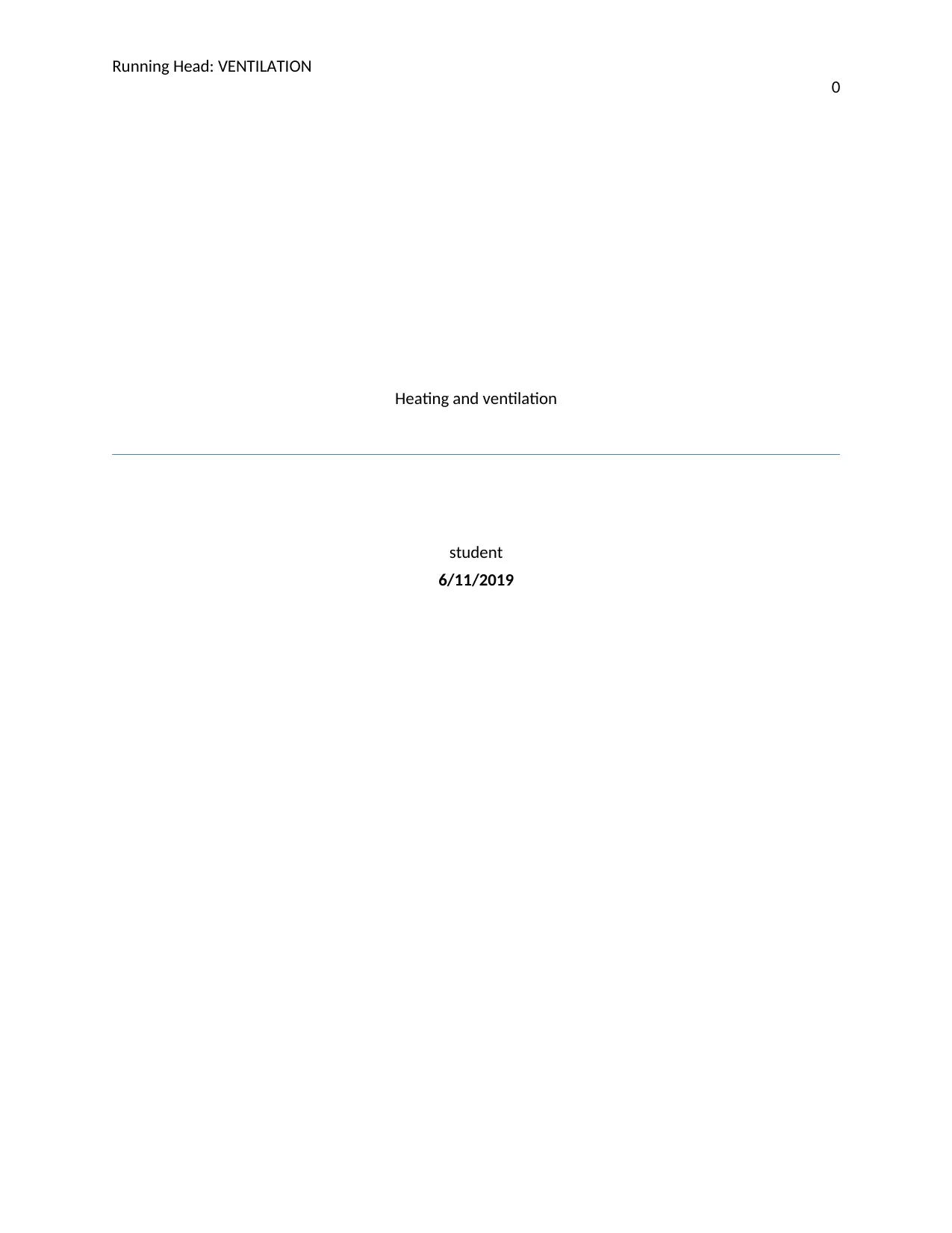
Running Head: VENTILATION
0
Heating and ventilation
student
6/11/2019
0
Heating and ventilation
student
6/11/2019
Paraphrase This Document
Need a fresh take? Get an instant paraphrase of this document with our AI Paraphraser
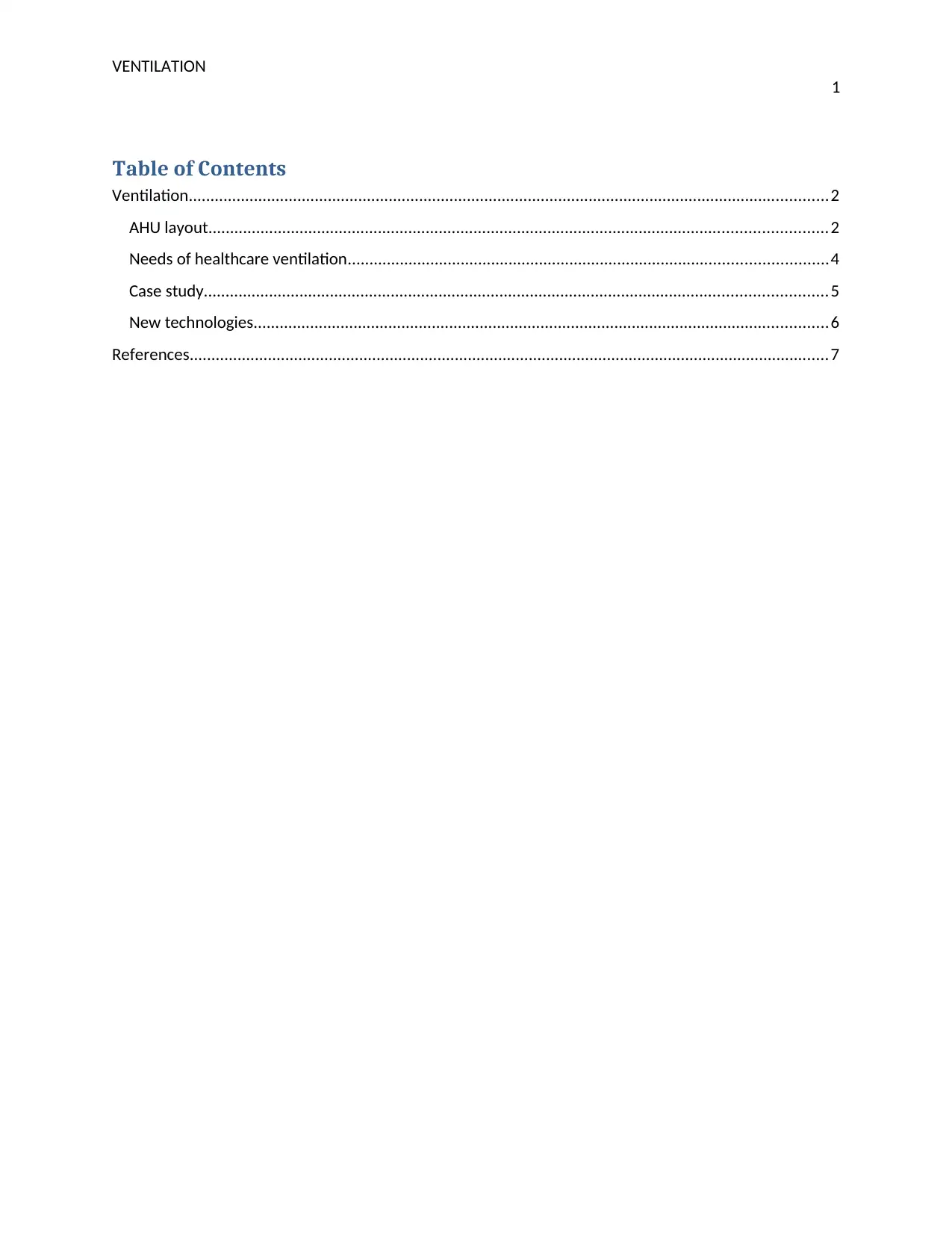
VENTILATION
1
Table of Contents
Ventilation...................................................................................................................................................2
AHU layout..............................................................................................................................................2
Needs of healthcare ventilation..............................................................................................................4
Case study...............................................................................................................................................5
New technologies....................................................................................................................................6
References...................................................................................................................................................7
1
Table of Contents
Ventilation...................................................................................................................................................2
AHU layout..............................................................................................................................................2
Needs of healthcare ventilation..............................................................................................................4
Case study...............................................................................................................................................5
New technologies....................................................................................................................................6
References...................................................................................................................................................7
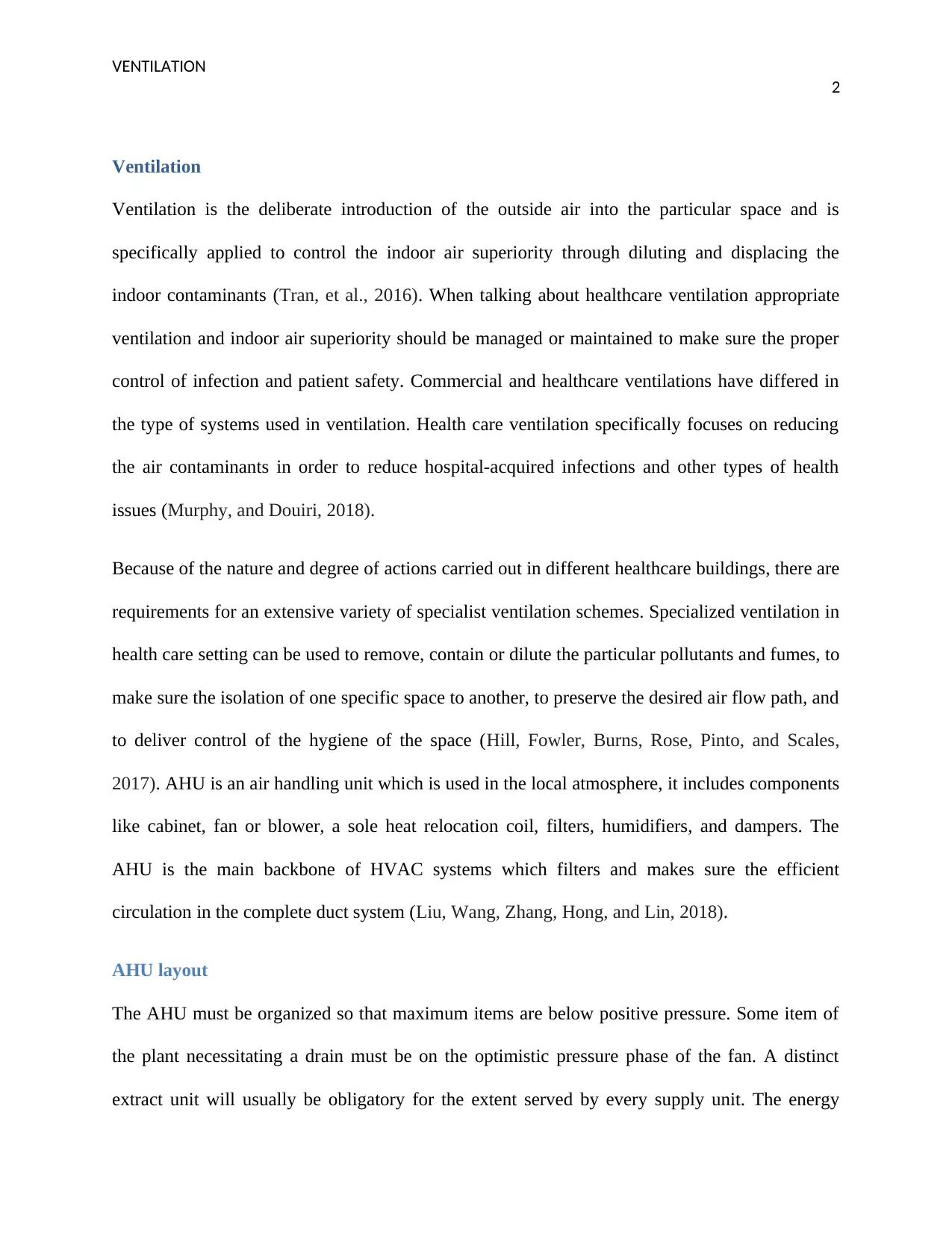
VENTILATION
2
Ventilation
Ventilation is the deliberate introduction of the outside air into the particular space and is
specifically applied to control the indoor air superiority through diluting and displacing the
indoor contaminants (Tran, et al., 2016). When talking about healthcare ventilation appropriate
ventilation and indoor air superiority should be managed or maintained to make sure the proper
control of infection and patient safety. Commercial and healthcare ventilations have differed in
the type of systems used in ventilation. Health care ventilation specifically focuses on reducing
the air contaminants in order to reduce hospital-acquired infections and other types of health
issues (Murphy, and Douiri, 2018).
Because of the nature and degree of actions carried out in different healthcare buildings, there are
requirements for an extensive variety of specialist ventilation schemes. Specialized ventilation in
health care setting can be used to remove, contain or dilute the particular pollutants and fumes, to
make sure the isolation of one specific space to another, to preserve the desired air flow path, and
to deliver control of the hygiene of the space (Hill, Fowler, Burns, Rose, Pinto, and Scales,
2017). AHU is an air handling unit which is used in the local atmosphere, it includes components
like cabinet, fan or blower, a sole heat relocation coil, filters, humidifiers, and dampers. The
AHU is the main backbone of HVAC systems which filters and makes sure the efficient
circulation in the complete duct system (Liu, Wang, Zhang, Hong, and Lin, 2018).
AHU layout
The AHU must be organized so that maximum items are below positive pressure. Some item of
the plant necessitating a drain must be on the optimistic pressure phase of the fan. A distinct
extract unit will usually be obligatory for the extent served by every supply unit. The energy
2
Ventilation
Ventilation is the deliberate introduction of the outside air into the particular space and is
specifically applied to control the indoor air superiority through diluting and displacing the
indoor contaminants (Tran, et al., 2016). When talking about healthcare ventilation appropriate
ventilation and indoor air superiority should be managed or maintained to make sure the proper
control of infection and patient safety. Commercial and healthcare ventilations have differed in
the type of systems used in ventilation. Health care ventilation specifically focuses on reducing
the air contaminants in order to reduce hospital-acquired infections and other types of health
issues (Murphy, and Douiri, 2018).
Because of the nature and degree of actions carried out in different healthcare buildings, there are
requirements for an extensive variety of specialist ventilation schemes. Specialized ventilation in
health care setting can be used to remove, contain or dilute the particular pollutants and fumes, to
make sure the isolation of one specific space to another, to preserve the desired air flow path, and
to deliver control of the hygiene of the space (Hill, Fowler, Burns, Rose, Pinto, and Scales,
2017). AHU is an air handling unit which is used in the local atmosphere, it includes components
like cabinet, fan or blower, a sole heat relocation coil, filters, humidifiers, and dampers. The
AHU is the main backbone of HVAC systems which filters and makes sure the efficient
circulation in the complete duct system (Liu, Wang, Zhang, Hong, and Lin, 2018).
AHU layout
The AHU must be organized so that maximum items are below positive pressure. Some item of
the plant necessitating a drain must be on the optimistic pressure phase of the fan. A distinct
extract unit will usually be obligatory for the extent served by every supply unit. The energy
⊘ This is a preview!⊘
Do you want full access?
Subscribe today to unlock all pages.

Trusted by 1+ million students worldwide
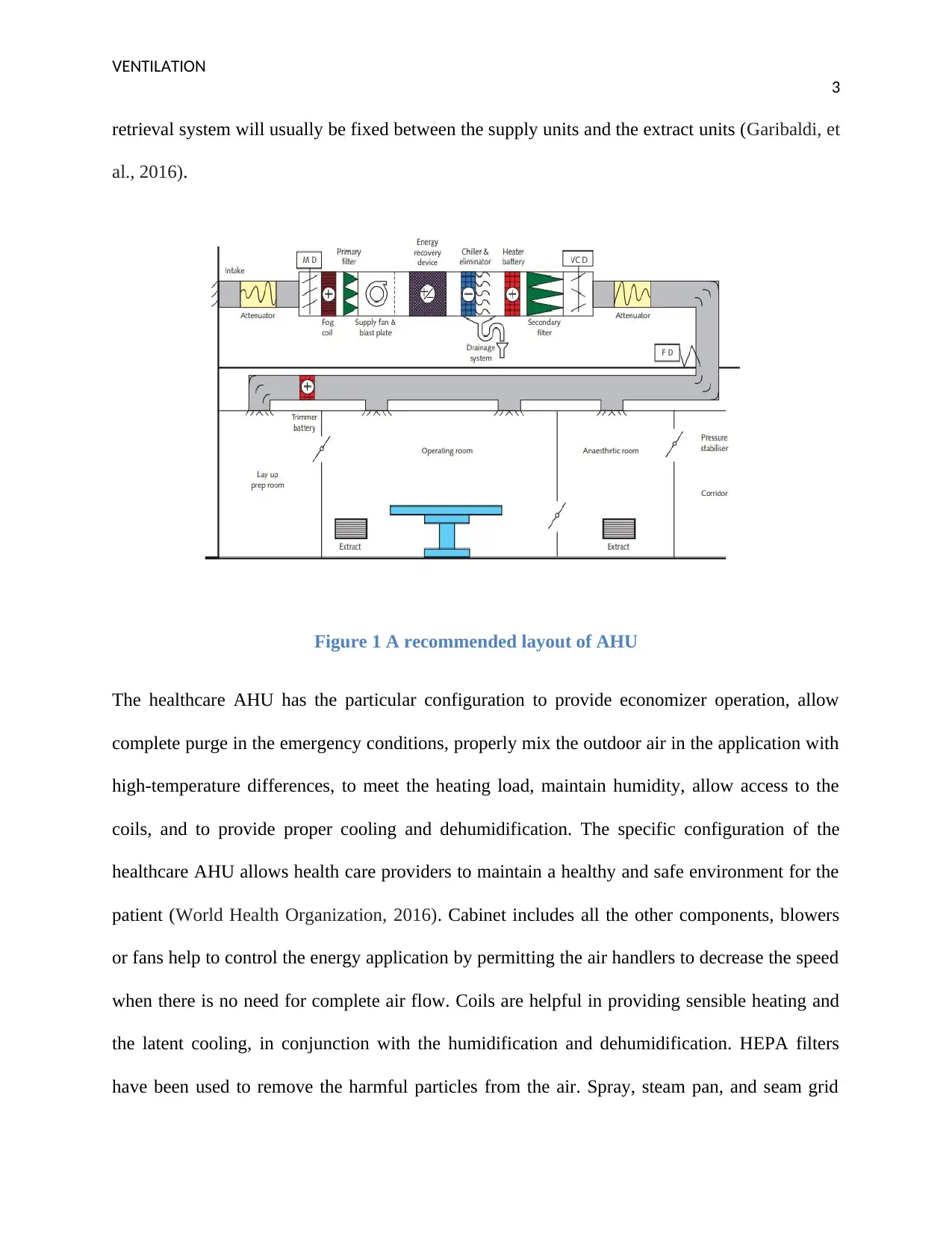
VENTILATION
3
retrieval system will usually be fixed between the supply units and the extract units (Garibaldi, et
al., 2016).
Figure 1 A recommended layout of AHU
The healthcare AHU has the particular configuration to provide economizer operation, allow
complete purge in the emergency conditions, properly mix the outdoor air in the application with
high-temperature differences, to meet the heating load, maintain humidity, allow access to the
coils, and to provide proper cooling and dehumidification. The specific configuration of the
healthcare AHU allows health care providers to maintain a healthy and safe environment for the
patient (World Health Organization, 2016). Cabinet includes all the other components, blowers
or fans help to control the energy application by permitting the air handlers to decrease the speed
when there is no need for complete air flow. Coils are helpful in providing sensible heating and
the latent cooling, in conjunction with the humidification and dehumidification. HEPA filters
have been used to remove the harmful particles from the air. Spray, steam pan, and seam grid
3
retrieval system will usually be fixed between the supply units and the extract units (Garibaldi, et
al., 2016).
Figure 1 A recommended layout of AHU
The healthcare AHU has the particular configuration to provide economizer operation, allow
complete purge in the emergency conditions, properly mix the outdoor air in the application with
high-temperature differences, to meet the heating load, maintain humidity, allow access to the
coils, and to provide proper cooling and dehumidification. The specific configuration of the
healthcare AHU allows health care providers to maintain a healthy and safe environment for the
patient (World Health Organization, 2016). Cabinet includes all the other components, blowers
or fans help to control the energy application by permitting the air handlers to decrease the speed
when there is no need for complete air flow. Coils are helpful in providing sensible heating and
the latent cooling, in conjunction with the humidification and dehumidification. HEPA filters
have been used to remove the harmful particles from the air. Spray, steam pan, and seam grid
Paraphrase This Document
Need a fresh take? Get an instant paraphrase of this document with our AI Paraphraser
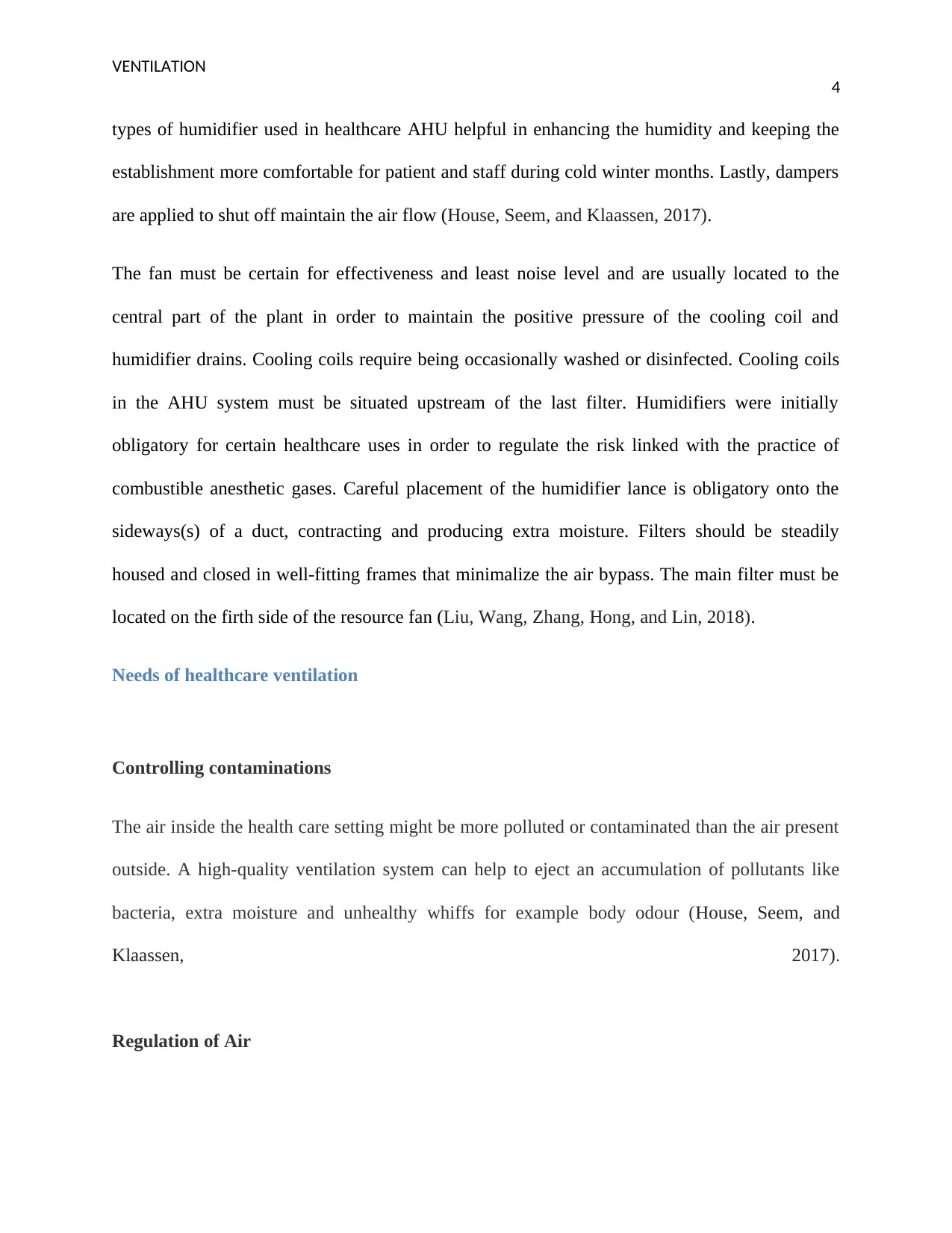
VENTILATION
4
types of humidifier used in healthcare AHU helpful in enhancing the humidity and keeping the
establishment more comfortable for patient and staff during cold winter months. Lastly, dampers
are applied to shut off maintain the air flow (House, Seem, and Klaassen, 2017).
The fan must be certain for effectiveness and least noise level and are usually located to the
central part of the plant in order to maintain the positive pressure of the cooling coil and
humidifier drains. Cooling coils require being occasionally washed or disinfected. Cooling coils
in the AHU system must be situated upstream of the last filter. Humidifiers were initially
obligatory for certain healthcare uses in order to regulate the risk linked with the practice of
combustible anesthetic gases. Careful placement of the humidifier lance is obligatory onto the
sideways(s) of a duct, contracting and producing extra moisture. Filters should be steadily
housed and closed in well-fitting frames that minimalize the air bypass. The main filter must be
located on the firth side of the resource fan (Liu, Wang, Zhang, Hong, and Lin, 2018).
Needs of healthcare ventilation
Controlling contaminations
The air inside the health care setting might be more polluted or contaminated than the air present
outside. A high-quality ventilation system can help to eject an accumulation of pollutants like
bacteria, extra moisture and unhealthy whiffs for example body odour (House, Seem, and
Klaassen, 2017).
Regulation of Air
4
types of humidifier used in healthcare AHU helpful in enhancing the humidity and keeping the
establishment more comfortable for patient and staff during cold winter months. Lastly, dampers
are applied to shut off maintain the air flow (House, Seem, and Klaassen, 2017).
The fan must be certain for effectiveness and least noise level and are usually located to the
central part of the plant in order to maintain the positive pressure of the cooling coil and
humidifier drains. Cooling coils require being occasionally washed or disinfected. Cooling coils
in the AHU system must be situated upstream of the last filter. Humidifiers were initially
obligatory for certain healthcare uses in order to regulate the risk linked with the practice of
combustible anesthetic gases. Careful placement of the humidifier lance is obligatory onto the
sideways(s) of a duct, contracting and producing extra moisture. Filters should be steadily
housed and closed in well-fitting frames that minimalize the air bypass. The main filter must be
located on the firth side of the resource fan (Liu, Wang, Zhang, Hong, and Lin, 2018).
Needs of healthcare ventilation
Controlling contaminations
The air inside the health care setting might be more polluted or contaminated than the air present
outside. A high-quality ventilation system can help to eject an accumulation of pollutants like
bacteria, extra moisture and unhealthy whiffs for example body odour (House, Seem, and
Klaassen, 2017).
Regulation of Air
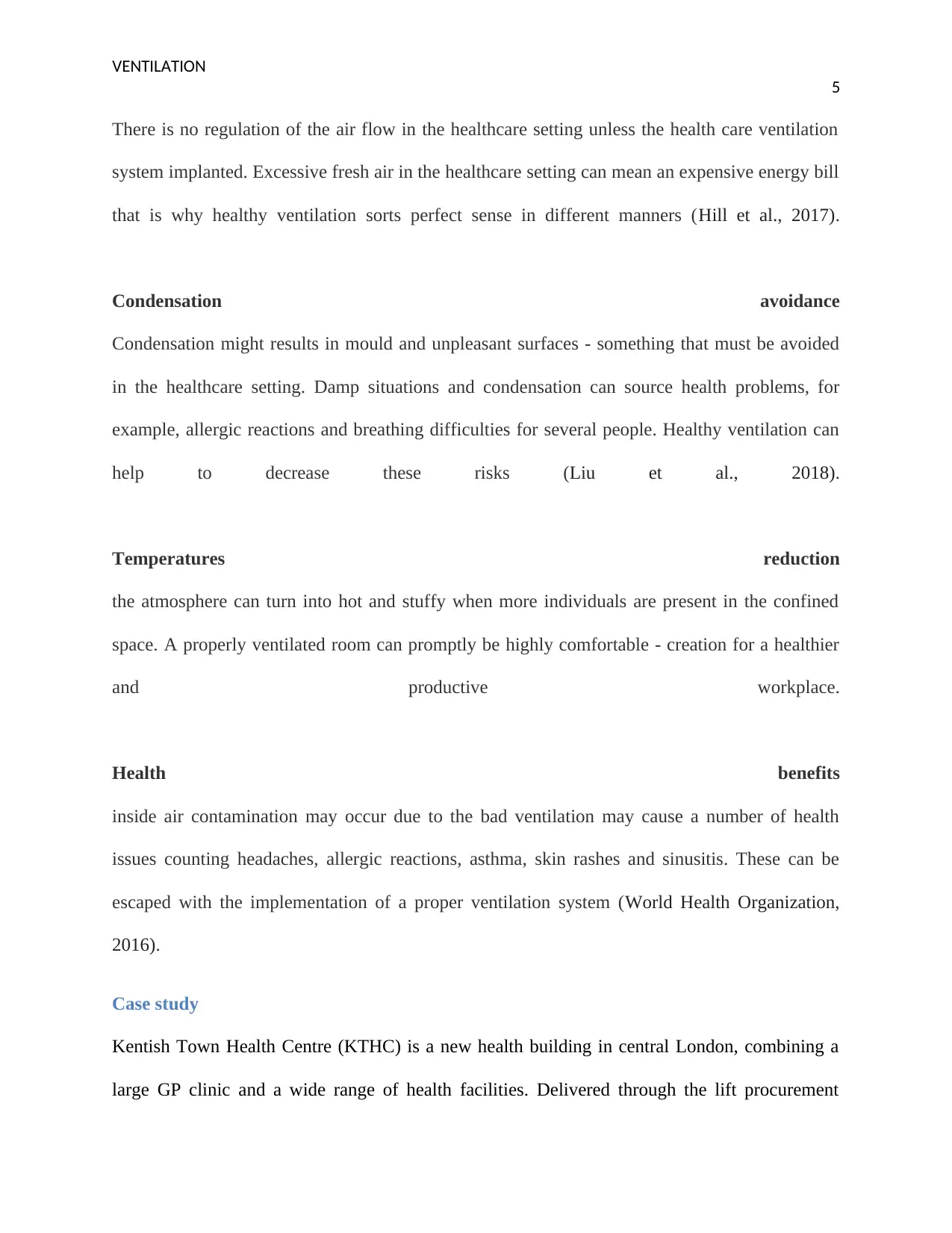
VENTILATION
5
There is no regulation of the air flow in the healthcare setting unless the health care ventilation
system implanted. Excessive fresh air in the healthcare setting can mean an expensive energy bill
that is why healthy ventilation sorts perfect sense in different manners (Hill et al., 2017).
Condensation avoidance
Condensation might results in mould and unpleasant surfaces - something that must be avoided
in the healthcare setting. Damp situations and condensation can source health problems, for
example, allergic reactions and breathing difficulties for several people. Healthy ventilation can
help to decrease these risks (Liu et al., 2018).
Temperatures reduction
the atmosphere can turn into hot and stuffy when more individuals are present in the confined
space. A properly ventilated room can promptly be highly comfortable - creation for a healthier
and productive workplace.
Health benefits
inside air contamination may occur due to the bad ventilation may cause a number of health
issues counting headaches, allergic reactions, asthma, skin rashes and sinusitis. These can be
escaped with the implementation of a proper ventilation system (World Health Organization,
2016).
Case study
Kentish Town Health Centre (KTHC) is a new health building in central London, combining a
large GP clinic and a wide range of health facilities. Delivered through the lift procurement
5
There is no regulation of the air flow in the healthcare setting unless the health care ventilation
system implanted. Excessive fresh air in the healthcare setting can mean an expensive energy bill
that is why healthy ventilation sorts perfect sense in different manners (Hill et al., 2017).
Condensation avoidance
Condensation might results in mould and unpleasant surfaces - something that must be avoided
in the healthcare setting. Damp situations and condensation can source health problems, for
example, allergic reactions and breathing difficulties for several people. Healthy ventilation can
help to decrease these risks (Liu et al., 2018).
Temperatures reduction
the atmosphere can turn into hot and stuffy when more individuals are present in the confined
space. A properly ventilated room can promptly be highly comfortable - creation for a healthier
and productive workplace.
Health benefits
inside air contamination may occur due to the bad ventilation may cause a number of health
issues counting headaches, allergic reactions, asthma, skin rashes and sinusitis. These can be
escaped with the implementation of a proper ventilation system (World Health Organization,
2016).
Case study
Kentish Town Health Centre (KTHC) is a new health building in central London, combining a
large GP clinic and a wide range of health facilities. Delivered through the lift procurement
⊘ This is a preview!⊘
Do you want full access?
Subscribe today to unlock all pages.

Trusted by 1+ million students worldwide
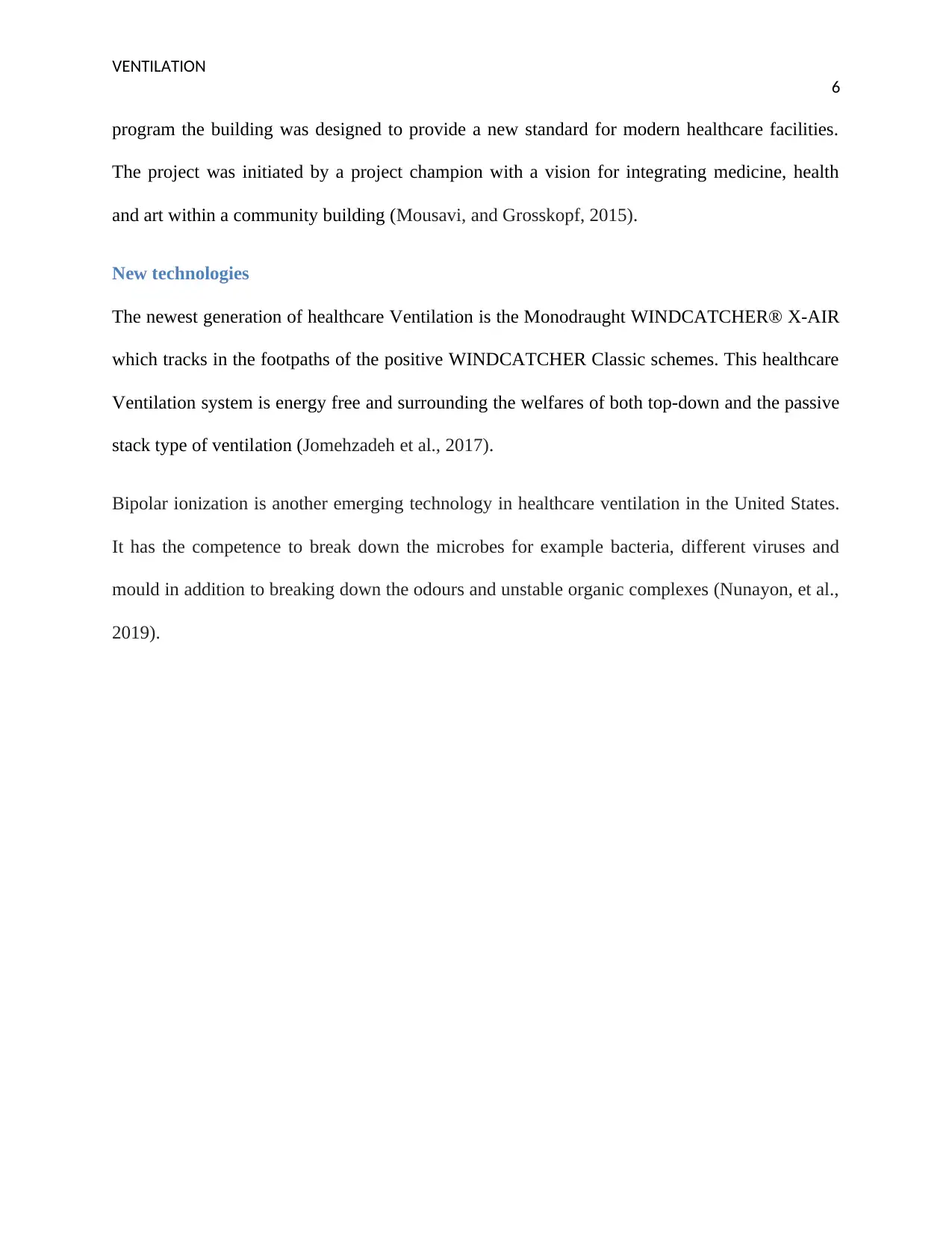
VENTILATION
6
program the building was designed to provide a new standard for modern healthcare facilities.
The project was initiated by a project champion with a vision for integrating medicine, health
and art within a community building (Mousavi, and Grosskopf, 2015).
New technologies
The newest generation of healthcare Ventilation is the Monodraught WINDCATCHER® X-AIR
which tracks in the footpaths of the positive WINDCATCHER Classic schemes. This healthcare
Ventilation system is energy free and surrounding the welfares of both top-down and the passive
stack type of ventilation (Jomehzadeh et al., 2017).
Bipolar ionization is another emerging technology in healthcare ventilation in the United States.
It has the competence to break down the microbes for example bacteria, different viruses and
mould in addition to breaking down the odours and unstable organic complexes (Nunayon, et al.,
2019).
6
program the building was designed to provide a new standard for modern healthcare facilities.
The project was initiated by a project champion with a vision for integrating medicine, health
and art within a community building (Mousavi, and Grosskopf, 2015).
New technologies
The newest generation of healthcare Ventilation is the Monodraught WINDCATCHER® X-AIR
which tracks in the footpaths of the positive WINDCATCHER Classic schemes. This healthcare
Ventilation system is energy free and surrounding the welfares of both top-down and the passive
stack type of ventilation (Jomehzadeh et al., 2017).
Bipolar ionization is another emerging technology in healthcare ventilation in the United States.
It has the competence to break down the microbes for example bacteria, different viruses and
mould in addition to breaking down the odours and unstable organic complexes (Nunayon, et al.,
2019).
Paraphrase This Document
Need a fresh take? Get an instant paraphrase of this document with our AI Paraphraser
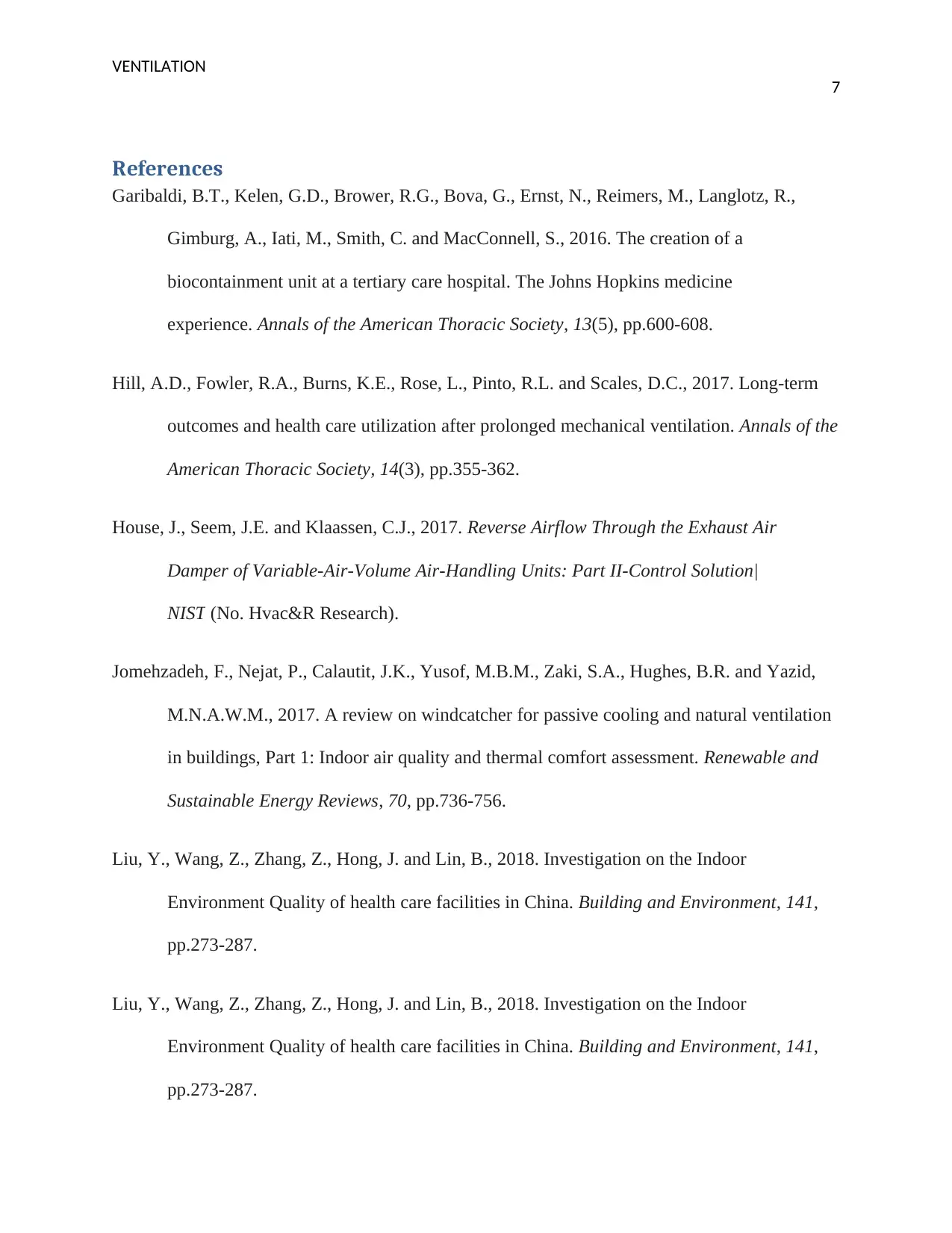
VENTILATION
7
References
Garibaldi, B.T., Kelen, G.D., Brower, R.G., Bova, G., Ernst, N., Reimers, M., Langlotz, R.,
Gimburg, A., Iati, M., Smith, C. and MacConnell, S., 2016. The creation of a
biocontainment unit at a tertiary care hospital. The Johns Hopkins medicine
experience. Annals of the American Thoracic Society, 13(5), pp.600-608.
Hill, A.D., Fowler, R.A., Burns, K.E., Rose, L., Pinto, R.L. and Scales, D.C., 2017. Long-term
outcomes and health care utilization after prolonged mechanical ventilation. Annals of the
American Thoracic Society, 14(3), pp.355-362.
House, J., Seem, J.E. and Klaassen, C.J., 2017. Reverse Airflow Through the Exhaust Air
Damper of Variable-Air-Volume Air-Handling Units: Part II-Control Solution|
NIST (No. Hvac&R Research).
Jomehzadeh, F., Nejat, P., Calautit, J.K., Yusof, M.B.M., Zaki, S.A., Hughes, B.R. and Yazid,
M.N.A.W.M., 2017. A review on windcatcher for passive cooling and natural ventilation
in buildings, Part 1: Indoor air quality and thermal comfort assessment. Renewable and
Sustainable Energy Reviews, 70, pp.736-756.
Liu, Y., Wang, Z., Zhang, Z., Hong, J. and Lin, B., 2018. Investigation on the Indoor
Environment Quality of health care facilities in China. Building and Environment, 141,
pp.273-287.
Liu, Y., Wang, Z., Zhang, Z., Hong, J. and Lin, B., 2018. Investigation on the Indoor
Environment Quality of health care facilities in China. Building and Environment, 141,
pp.273-287.
7
References
Garibaldi, B.T., Kelen, G.D., Brower, R.G., Bova, G., Ernst, N., Reimers, M., Langlotz, R.,
Gimburg, A., Iati, M., Smith, C. and MacConnell, S., 2016. The creation of a
biocontainment unit at a tertiary care hospital. The Johns Hopkins medicine
experience. Annals of the American Thoracic Society, 13(5), pp.600-608.
Hill, A.D., Fowler, R.A., Burns, K.E., Rose, L., Pinto, R.L. and Scales, D.C., 2017. Long-term
outcomes and health care utilization after prolonged mechanical ventilation. Annals of the
American Thoracic Society, 14(3), pp.355-362.
House, J., Seem, J.E. and Klaassen, C.J., 2017. Reverse Airflow Through the Exhaust Air
Damper of Variable-Air-Volume Air-Handling Units: Part II-Control Solution|
NIST (No. Hvac&R Research).
Jomehzadeh, F., Nejat, P., Calautit, J.K., Yusof, M.B.M., Zaki, S.A., Hughes, B.R. and Yazid,
M.N.A.W.M., 2017. A review on windcatcher for passive cooling and natural ventilation
in buildings, Part 1: Indoor air quality and thermal comfort assessment. Renewable and
Sustainable Energy Reviews, 70, pp.736-756.
Liu, Y., Wang, Z., Zhang, Z., Hong, J. and Lin, B., 2018. Investigation on the Indoor
Environment Quality of health care facilities in China. Building and Environment, 141,
pp.273-287.
Liu, Y., Wang, Z., Zhang, Z., Hong, J. and Lin, B., 2018. Investigation on the Indoor
Environment Quality of health care facilities in China. Building and Environment, 141,
pp.273-287.

VENTILATION
8
Mousavi, E.S. and Grosskopf, K.R., 2015. Ventilation rates and airflow pathways in patient
rooms: A case study of bioaerosol containment and removal. Annals of Occupational
Hygiene, 59(9), pp.1190-1199.
Murphy, P.B. and Douiri, A., 2018. Patients, caregivers and health system costs of home
ventilation.
Nunayon, S.S., Zhang, H.H., Jin, X. and Lai, A.C., 2019. Experimental evaluation of positive
and negative air ion disinfection efficacy under different ventilation duct
conditions. Building and Environment.
Tran, H.T., Tran, A.A., Tran, J.P., Tran, P.G. and Villalobos, M.P., 2016. Superior Central Air
Ventilation System. U.S. Patent Application 14/486,626.
World Health Organization, 2016. Decontamination and reprocessing of medical devices for
health-care facilities.
8
Mousavi, E.S. and Grosskopf, K.R., 2015. Ventilation rates and airflow pathways in patient
rooms: A case study of bioaerosol containment and removal. Annals of Occupational
Hygiene, 59(9), pp.1190-1199.
Murphy, P.B. and Douiri, A., 2018. Patients, caregivers and health system costs of home
ventilation.
Nunayon, S.S., Zhang, H.H., Jin, X. and Lai, A.C., 2019. Experimental evaluation of positive
and negative air ion disinfection efficacy under different ventilation duct
conditions. Building and Environment.
Tran, H.T., Tran, A.A., Tran, J.P., Tran, P.G. and Villalobos, M.P., 2016. Superior Central Air
Ventilation System. U.S. Patent Application 14/486,626.
World Health Organization, 2016. Decontamination and reprocessing of medical devices for
health-care facilities.
⊘ This is a preview!⊘
Do you want full access?
Subscribe today to unlock all pages.

Trusted by 1+ million students worldwide
1 out of 9
Your All-in-One AI-Powered Toolkit for Academic Success.
+13062052269
info@desklib.com
Available 24*7 on WhatsApp / Email
![[object Object]](/_next/static/media/star-bottom.7253800d.svg)
Unlock your academic potential
Copyright © 2020–2025 A2Z Services. All Rights Reserved. Developed and managed by ZUCOL.